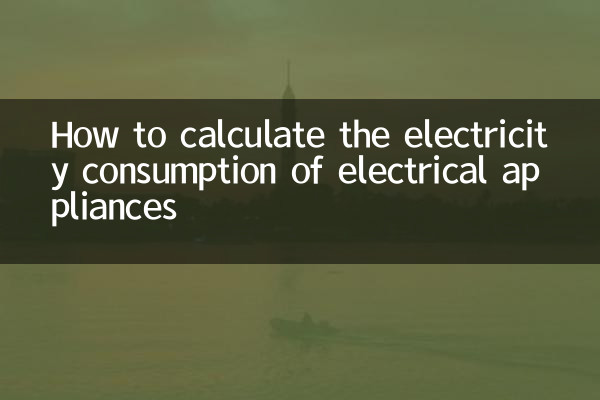How to calculate the electricity consumption of electrical appliances
In modern life, the electricity consumption of electrical appliances is directly related to the electricity expenses of households or businesses. Knowing how to calculate the electricity consumption of electrical appliances can not only help you plan your electricity usage properly, but also save energy bills. This article will introduce in detail the method of calculating the electricity consumption of electrical appliances and provide structured data for reference.
1. Basic formula for calculating the electricity consumption of electrical appliances

The electricity consumption of an appliance is usually calculated by the following formula:
Electricity consumption (kilowatt hour, kWh) = power (kilowatt, kW) × usage time (hour, h)
Where, wattage is the rated power of the appliance, usually measured in watts (W). 1 kilowatt (kW) = 1000 watts (W). For example, an electrical appliance with a power of 1000W consumes 1kWh of electricity when running for 1 hour.
2. Examples of power and electricity consumption of common electrical appliances
The following are the wattages and typical electricity usage of some common household appliances:
| Appliance name | Power (W) | Usage time (hours) | Electricity consumption (kWh) |
|---|---|---|---|
| Air conditioner (1.5 HP) | 1200 | 8 | 9.6 |
| Refrigerator (200L) | 150 | 24 | 3.6 |
| TV (55 inches) | 100 | 5 | 0.5 |
| Electric water heater (2000W) | 2000 | 1 | 2 |
| Washing machine (5kg) | 500 | 0.5 | 0.25 |
3. How to calculate electricity consumption through meter readings
In addition to power calculation, electricity consumption can also be obtained directly from meter readings:
Electricity consumption (kWh) = current meter reading – last meter reading
For example, if the meter reading was 500kWh last month and 600kWh this month, then the electricity consumption this month is 100kWh.
4. Other factors affecting electricity consumption
1.Frequency of use: The longer an electrical appliance is used, the greater its power consumption.
2.Power fluctuation: The power of some electrical appliances (such as air conditioners) will change under different working conditions.
3.Standby power consumption: Even if the appliance is not running, it may consume a small amount of power in standby mode.
5. How to reduce the electricity consumption of electrical appliances
1.Choose high-efficiency appliances: Purchase electrical appliances with high energy efficiency levels (such as Level 1 energy efficiency).
2.fair use: Avoid turning on high-power electrical appliances for a long time.
3.Regular maintenance: Clean appliances (such as air conditioner filters) to improve efficiency.
6. Hot topics: Hot topics related to electricity consumption that have attracted the attention of the whole network recently.
In the past 10 days, hot topics about electricity consumption on the Internet include:
| Hot content | focus of discussion |
|---|---|
| Peak electricity consumption in summer | Many places have issued power-saving initiatives and air-conditioning temperature setting recommendations. |
| New energy vehicle charging costs | Comparison of electricity costs between home charging piles and public charging piles |
| Popularization of smart meters | Remote meter reading and real-time monitoring of electricity consumption data |
| New standards for energy efficiency of home appliances | Adjustments to energy efficiency levels of some home appliances in 2024 |
Conclusion
Knowing how to calculate the electricity consumption of electrical appliances can help you better manage your home’s energy consumption. By rationally using electrical appliances and choosing high-efficiency products, you can save electricity bills and contribute to environmental protection. I hope the data and methods provided in this article can bring convenience to your life.

check the details

check the details